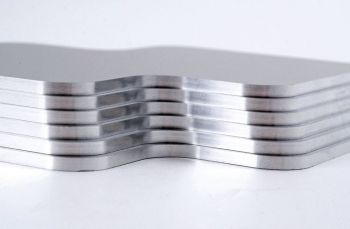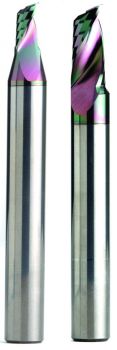Cutting aluminium on a CNC router
Taking the pain out of cutting aluminium


Top tips for routing alumimium
- Advanced coatings extend tool life by around 10 times compared with a standard carbide router tool.
- Much higher feed rates and consistent quality of cut means a reduction in labour and overall costs.
- DLC coated tools typically achieve a feed rate of 2 meters per minute through 3mm aluminium in a single cut.
- Superior coated tools are designed for high speed routing of 10-12 meters per minute on 3mm aluminium in a single cut.
- If the machine is solely used for aluminium, then coolant or cutting fluid can be used to achieve even faster feed rates and longer tool life.
- To achieve the best results, the machine will need a smooth spindle,good vacuum hold down and extraction and be well maintained.

DLC coated tools are best suited for smaller letters or shapes where a faster cut speed is not possible due to the vacuum bed hold down or machine.
Routing aluminium has always been a problem area for certain companies that usually have an expensive CNC machine which happily cuts plastics, foams, PVCs and aluminium composite with ease. However, when asked to cut solid aluminium, there is usually a sudden intake of breath through gritted teeth. Liam Hodson, tooling & machine consultant at LKH Tools provides some guidelines. Routing aluminium has become, year on year, increasingly popular within the sign industry. A sympathetic attitude toward the difficulties faced by a production manager or machine operator must be acknowledged. Historically, this was a slow and messy process using plenty of coolant or oil to stop tooling from binding up. If the coolant stopped for some reason, the tool would break or weld the aluminium back to the sheet.
It was necessary to clean down the machinery before restarting production on the next material (oil and MDF is not a good mix). The aluminium required cleaning prior to powder coating/painting and in most cases, it had to be hand finished to remove any burrs or sharp edges. The inevitable “we’ll sub-contract this out” was understandable.
Dry cutting of aluminium has always been a very difficult and in most situations, an inconsistent or impossible goal to achieve. However, this does not have to be the case.
Although CNC machines have not really changed much in the last decade or so, the tooling technology which goes into the machines has recently had a quantum leap forward with the introduction of the DLC and new Superior coated tools from Crown Norge (available in the UK from LKH Tools).
Friction-reducing coatings
The new coatings on the highest quality Swiss carbide tooling provide a huge reduction in friction when cutting aluminium dry. These advanced coatings provide huge benefits when comparing standard tool life. In the case of the Superior tool, this will last approximately 10 times or longer in comparison to a standard carbide router tool.
It is now possible to consistently cut a mixed batch of materials without worrying about cross contamination of oil and material. This allows the machine operator full freedom to fully utilise the amount of hours in a working day (eg an emergency aluminium rush job could be very easily inserted between a production run of plastics or foam PVC).
Although the DLC and Superior coatings add a premium to the overall tool cost, much higher feed rates and consistent quality of cut means a reduction in labour and overall costs.
The finish is exceptional and can be handled straight off the machine due to the combination of the coating and geometry of the tool. This, combined with the extra longevity of the tool, makes them the most cost effective option on the market today.
DLC coated tools are best suited for smaller letters or shapes where a faster cut speed is not possible due to the vacuum bed hold down or machine limitations. Typically, these tools achieve a feed rate of 2 meters per minute through 3mm aluminium in a single cut.
These new Superior coated tools are designed for high speed routing of 10-12 meters per minute on 3mm aluminium in a single cut. Vibration at such high speeds is significantly reduced due to the new coating which provides an additional 60% reduction in friction against standard coated tools.
The fast helix on these tools are best suited for larger panels or signs where the machine can get up to speed without any fear of the vacuum not holding the material or shape in place.
Coolant or cutting fluid
If the machine is solely used for aluminium, then coolant or cutting fluid such as oil or white water (preferred option) can be used to achieve even faster feed rates and longer tool life.This is, of course, at the expense of cleaning the product and machine afterward. As with all tools, the machine will need to have a number of correct cutting conditions to obtain the optimum result. The quickest way to tool failure or a poor cut finish is vibration during cutting.
Strong vacuum hold down
Not only can this prematurely cause the tool to fail, it can also cause damage to the machine spindle. A good strong vacuum hold down is essential to help prevent this.
To assist with the vacuum hold down, the extraction system must remove the debris efficiently. If the machine bed is covered in debris or chippings, the vacuum hold down will not work correctly and, therefore, introduce vibration into the sheet.
The machine routing spindle must be in good condition with smooth and free running bearings as vibration can also be created this being out of balance.
In addition, the collet and tool holder must be concentric. Worn or damaged collets or tool holders will not hold the tool evenly when spun at high RPM.
Once an assessment of the product has been undertaken and compliance is proven, a technical file of supporting evidence is compiled.
These should be replaced regularly as part of the routine maintenance and/or after a tool breaking.The limitations of the machine should also be understood and expectations adjusted accordingly.
A small, lightweight machine with a low powered spindle will not be able to achieve the same feed rates of its larger more robust alternative.
LEach machine will be slightly different in its operation and performance, however, if these cutting conditions are met, then the best results can be obtained for that particular machine.
